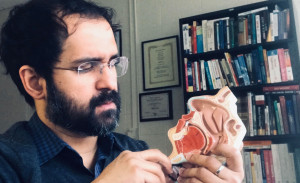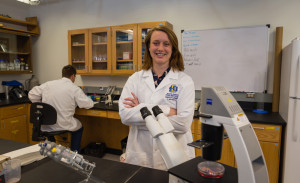The battle against the novel coronavirus has begun at South Dakota State University. More than 20 researchers are investigating ways to prevent the spread of severe acute respiratory syndrome coronavirus 2, which causes COVID-19.
One engineering researcher has already received National Science Foundation funding and the university’s COVID-19 working group has submitted its first proposal. Others will follow as funding becomes available.
Improving respirator masks
Assistant mechanical engineering professor Saikat Basu was the first SDSU researcher to receive NSF funding for COVID-19 research. He is working with researchers at Cornell University and the University of Illinois at Urbana-Champaign to design a reusable mask with a respirator that will capture and kill the novel coronavirus.

Assistant mechanical engineering professor Saikat Basu is the first SDSU faculty member to receive National Science Foundation funding for COVID-19 research.
The internal structure of the respirator is modeled after the nasal cavities of animals, such as pigs and dogs, that have a keen sense of smell, Basu explained. That unique structure will help trap the aerosol virus droplets, which then adhere to and are deactivated through a combination of copper-based filters and temperature changes in the respirator walls.
“The idea is to have better technologies to reduce virus transmission in hospital settings and to protect uninfected populations,†Basu said. The collaborative project will be supported by a one-year, $200,000 grant obtained through the NSF Rapid Response Research funding mechanism.
Detecting SARS-CoV-2
Associate chemistry and biochemistry professor Adam Hoppe leads the COVID-19 working group. The team includes researchers from the departments of biology and microbiology, chemistry and biochemistry, veterinary and biomedical sciences, and the colleges of Nursing and Pharmacy and Allied Health Professions, as well as the E.A. Martin Program in Human Nutrition and the South Dakota Animal Disease Research and Diagnostic Laboratory. The group has expertise in epidemiology, virology, immunology and diagnostics.
Early on, veterinary and biomedical sciences department researchers at the ADRDL began developing antibody tests and generating reagents, chemicals that detect the novel coronavirus, according to Hoppe. Professor and department head Jane Christopher-Hennings, Distinguished Professor and assistant department head Eric Nelson and research associate Steve Lawson are leading this effort.
“Eric has a long history of working on coronaviruses in animals and also worked on SARS CoV-1 and has published papers on that as well,†Hoppe explained. “Jane and her team have a lot of expertise that is very pertinent to the pandemic.â€

Assistant professor of biology and microbiology Natalie Thiex leads the epidemiology group that is working with regional health care providers to measure antibody responses, track viral spread and test hypotheses about protective factors for COVID-19 in South Dakota.
In collaboration with diagnostic efforts, assistant professor Natalie Thiex, who leads the epidemiology group, and professor Bonny Specker are working with regional health care providers to measure antibody responses, track viral spread and test hypotheses about protective factors for COVID-19 in South Dakota. Their work will help determine how many South Dakotans develop immunity to the novel coronavirus.
“That number is larger than those currently being tested,†Hoppe said. To do this, the researchers use a blood sample to ascertain whether an individual has developed antibodies to the virus. This will help them understand how widespread COVID-19 infections have been, including those who recovered without being hospitalized and those with mild symptoms who did not realize they had COVID-19.
Testing for protective antibodies, searching for protective genes
Hoppe and research associate Jason Kerkvliet have been developing a safe test to detect neutralizing antibodies that can prevent the virus from infecting cells. To do this, Hoppe, Nelson and professor Feng Li, a virologist in the Department of Biology and Microbiology, are working to create a pseudovirus.
“Now, the only way to measure neutralizing antibodies is to culture clinical isolates of the live virus. That is a higher risk method that requires a biosafety level 3 laboratory; not every hospital or lab can do that,†Hoppe explained. The pseudovirus is a viral-like particle that can be used to measure neutralizing antibodies while requiring only biosafety level 2. This tool can then be used to study the virus and to evaluate whether there are neutralizing antibodies in plasma prior to transfusion.
In addition, Hoppe and his team plan to use the pseudovirus along with CRISPR gene-editing tools to look for genes that may inhibit or contribute to viral infection using a new approach they developed at SDSU. The team has submitted a proposal for NSF RAPID funding to support their work. The genome sequencing facility, led by professor Jose Gonzalez, will play an integral role in this part of the research.
“Vaccine development will take time, so we need to tackle this virus from every direction,†Hoppe concluded.
– Christie Delfanian







